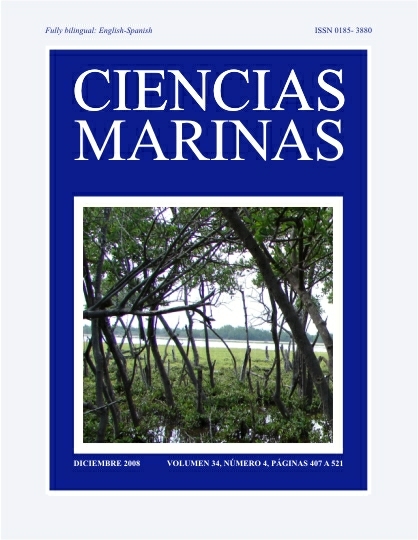Influence of alkali treatment on agar from Gracilariopsis longissima and Gracilaria vermiculophylla from the Gulf of California, Mexico
Main Article Content
Abstract
The effect of alkali treatment on agar yield, sulfate content, and 3,6 anhydrogalactose content from two agarophyte species (Gracilariopsis longissima and Gracilaria vermiculophylla) was analyzed. In addition, gel strength was measured in each agar extract as well as gelling and melting temperatures. Agar was extracted after pretreatment with different concentrations of NaOH (3%, 5%, 7%, and 9%). Pretreatment with alkali significantly reduced agar yield from G. longissima from 13.2% in nontreated agar (native agar) to 5.4% in 5% NaOH, whereas in G. vermiculophylla it diminished from 25.2% to 9.6% in 9% NaOH treatment. Statistically significant differences were observed for native and all alkali treatments in G. longissima, whereas in G. vermiculophylla significant differences were only found among native and high alkali treatments (7% and 9% NaOH, P < 0.05). Sulfate content from G. longissima diminished gradually with increasing alkali concentration, from high (3.9%) in native agar to low (3.1%) in 7% alkali treatment, and was negatively correlated with gel strength (r = –0.92). Sulfate content in G. vermiculophylla native agar was twice as high as that found in G. longissima (7.8%) and did not show statistically significant differences with low alkali treatments, but it did with high NaOH treatments. Higher contents of 3,6 anhydrogalactose were found with 9% NaOH treatment in G. longissima (40.9%) and G. vermiculophylla (43%), and they were significantly correlated with gel strength (r = 0.89 and r = 0.91, respectively).
Downloads
Article Details
This is an open access article distributed under a Creative Commons Attribution 4.0 License, which allows you to share and adapt the work, as long as you give appropriate credit to the original author(s) and the source, provide a link to the Creative Commons license, and indicate if changes were made. Figures, tables and other elements in the article are included in the article’s CC BY 4.0 license, unless otherwise indicated. The journal title is protected by copyrights and not subject to this license. Full license deed can be viewed here.

